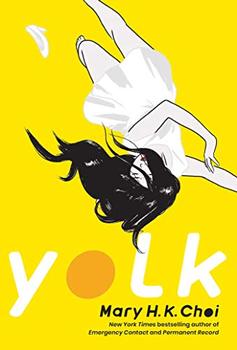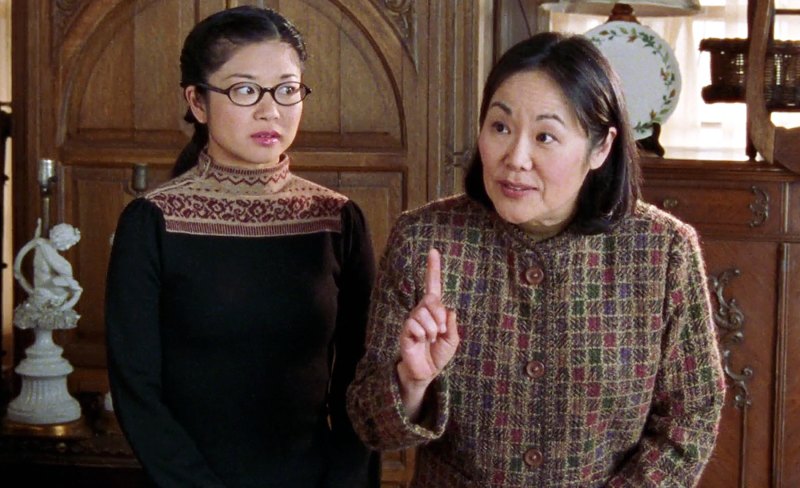Summary | Excerpt | Reviews | Beyond the Book | Read-Alikes | Genres & Themes | Author Bio

This article relates to Yolk
In Mary H.K. Choi's Yolk, June is particularly fond of the Warner Brothers (WB) Network television series Gilmore Girls. At first glance, the show seems like a somewhat anachronistic and unlikely pop culture presence in the novel. Set in Connecticut, it first aired in 2000; Choi's characters June and Jayne, Korean American sisters living in contemporary New York City, are only a few years out of high school, meaning they may have been too young to watch the show at the time it was originally broadcast. However, as Jayne explains it, their family didn't have cable, so instead of watching television, they marathoned the Gilmore Girls and Friends box sets over and over on a DVD player their father purchased on sale from Costco. The show is a marker of their working-class immigrant upbringing, in which their parents sought to save money while pouring their attention into the family business and the girls spent time alone finding ways to entertain themselves. It also holds further layers of significance specific to their childhood and identities, most notably in that it features a relatively early example of a series regular Korean American television character, Lane Kim (Keiko Agena).
Gilmore Girls is a feel-good comedy-drama depicting a modern, idealized version of America. It was never as wildly popular as June and Jayne's other favorite show, the sitcom Friends, and it was placed in the challenging position of airing at the same time as the NBC hit (Thursdays at 8 p.m.) when it debuted in October of 2000. Despite this, it survived to see a different time slot and six more seasons, and has kept a loyal and active fan base to this day.
Gilmore Girls follows Lorelai (Lauren Graham) and her teenage daughter Rory (Alexis Bledel), who live in the fictional town of Stars Hollow. After having become pregnant when she was a teenager herself, Lorelai rebelled against her wealthy parents' wishes, choosing single motherhood and working at a local inn over the more prestigious life they imagined for her. The ongoing tension between Lorelai and her parents as well as Rory's desire for independence in her own adolescence form the basis for much of the drama of the show, which is focused on relationships — both familial and romantic — and features light, humorous dialogue. It could be the gentle escapism offered by the balance of these qualities that continues to give it enduring appeal more than 20 years after the first episodes were broadcast.
 The show may appeal to Asian American audiences for an additional reason. While Lorelai and Rory are white, Rory's best friend, Lane, is Korean. At one point in Yolk, after June remarks to Jayne that she should improve her Korean language skills by watching K-dramas, Jayne questions her sister's television habits, noting, "Um, excuse me, you only ever watch Gilmore Girls." After pointing out that her own Korean is better than Jayne's, June launches an additional defense: "Two words: Lane Kim."
The show may appeal to Asian American audiences for an additional reason. While Lorelai and Rory are white, Rory's best friend, Lane, is Korean. At one point in Yolk, after June remarks to Jayne that she should improve her Korean language skills by watching K-dramas, Jayne questions her sister's television habits, noting, "Um, excuse me, you only ever watch Gilmore Girls." After pointing out that her own Korean is better than Jayne's, June launches an additional defense: "Two words: Lane Kim."
As Naureen Khan points out in an article for Zora, the character of Lane came about during what can be viewed as a transition stage, and also something of a dead zone, for Asian representation in American television. Chronologically, it fell between the short-lived All-American Girl starring comedian Margaret Cho, the first-ever Asian American sitcom, and the appearance of character Cristina Yang in Grey's Anatomy played by Sandra Oh, now of Killing Eve fame. Lane's story was, in a sense, typical of depictions of young people in immigrant families, positioning her love of drumming and rock music opposite her parents' traditional and religious values, but it resonated with audiences. As Khan writes, "Although her arc told of that familiar struggle of second-generation passions crashing into first-generation expectations — now a tried-and-true formula for immigrant stories — it was done with such tenderness that it was a salve for disobedient teenage daughters everywhere."
The success of the character can be partly explained by the care that was put into constructing her. Lane was based on Helen Pai, show creator Amy Sherman Palladino's real-life best friend. Pai worked with the show as a script coordinator and producer, and her mother was occasionally brought in as a cultural consultant. This showed a level of consideration not given to Margaret Cho's character on the earlier All-American Girl, with its "butchered Korean language and pseudotraditions" — as John H. Lee put it in LA Weekly. Cho herself also later addressed the mental and emotional distress she experienced while filming the show in her stand-up comedy and her memoir I'm the One That I Want.
As a young Korean American adult coming of age around the advent of Gilmore Girls, I was aware of Cho's comedy, and my consciousness of her struggles in the television industry inadvertently caused me to miss out on Lane's character in the WB show. Simply put, I expected American network TV to abuse Asian characters and actors, so I didn't look for Asian characters, or pay attention to television closely at all during that time.
Saying that I missed out isn't to suggest that there aren't plenty of criticisms of how Lane's character and place in the show were ultimately handled. Many fans were disappointed with how her story wrapped up, feeling that she was not given the ending she deserved. Also, Keiko Agena, who played Lane, is not of Korean descent but Japanese American. This type of cross-ethnic casting is a complex issue that not all entertainment writers and critics — Asian or otherwise — agree on, but it does raise concerns about viewing Asian people as a monolith, the dangers of which can be seen outside of but still in tandem with the entertainment industry, especially since former-President Trump's labeling of COVID-19 as the "China virus," alongside more insidious anti-China rhetoric engaged by the American media and general public, has contributed to increasing hate crimes against Asian people in the United States — particularly women. While the primary problem with racism directed towards Asian populations isn't its inaccuracy, this blurring of identities is one symptom of the lack of care and consideration given by the U.S. to Asian communities (many of which are diasporas of its own making), and that continued lack is visible virtually everywhere, including television.
Recently, in conversation with someone close to me, I mentioned my unease (to say the least) at increasing anti-Asian violence in the U.S. along with the fact that I was reading Yolk. The subject of Gilmore Girls came up, and she told me I should watch it. "It's what you watch when you can't handle a single second of real life," she said. Having started it, I understand. The drama is convincing, but neat and performance-driven; unlike life, it never feels out of control. I can see why June, who has experienced numerous frustrations and stresses at a young age, including a cancer diagnosis, would turn to it for comfort. I also understand why she and Jayne seem to prefer it over the more iconic Friends: Of the two shows, it's the underdog, like them.
However, while the series may depict its female characters as rebels, it isn't rebellious in and of itself. It's a relaxed picture of American normalcy — almost by definition, white American normalcy — that magically, by some stroke of luck, welcomes Choi's Korean characters without demanding anything of them in return. It isn't by any means perfect, and people of color's existence in a white world never ceases to be fraught, but it's a place where the girls can temporarily rest, a place where they can imagine they belong without ever having had to ask or work for it, and that's enough for June to defend the show, and its characters, fiercely. When Jayne makes the mistake of criticizing Lane's mother, June scolds her younger sister, almost speaking as if the woman is someone they know: "That Mom had a lot of disappointments in her life … You can tell she's seen shit. Show some respect."
Keiko Agena and Emily Kuroda as Lane and Mrs. Kim in Gilmore Girls, courtesy of Us Weekly
Filed under Cultural Curiosities
![]() This "beyond the book article" relates to Yolk. It originally ran in April 2021 and has been updated for the
March 2022 paperback edition.
Go to magazine.
This "beyond the book article" relates to Yolk. It originally ran in April 2021 and has been updated for the
March 2022 paperback edition.
Go to magazine.
Your guide toexceptional books
BookBrowse seeks out and recommends the best in contemporary fiction and nonfiction—books that not only engage and entertain but also deepen our understanding of ourselves and the world around us.